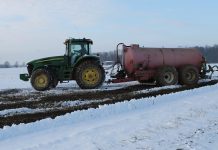On June 17, the Muskingum River Watershed joint board of Soil and Water Conservation Districts met for the first time.
The formation of the 20 county joint board is one of the first steps to establish nutrient credit trading within the Muskingum River Watershed.
Water quality
Nutrient credit trading can be a cost-effective way for county wastewater treatment plants or other point sources of discharge to upgrade facilities or renew permits by using conservation practices to offset nutrient discharges.
Soil and water conservation districts constantly promote voluntary water quality improvement within their boundaries, however district boundaries rarely encompass entire watersheds. The formation of the joint board in the Muskingum River Watershed formally allows the districts within the watershed to work together to facilitate credit trading.
Officers elected
At the June 17 meeting, the following individuals were elected to serve as officers: John Sigrist, chairman (Tuscarawas); Robert Winbigler, vice chair (Richland); Scott Briggs, secretary (Stark); Matt Peart, fiscal agent (Wayne); and Harold Neuenschwander, technical committee representative (Holmes).
Joint board action authorized the formation of a technical committee that that will work to review the mechanics of trading as well as discuss with Ohio EPA establishing a trading area.
The Alpine project
A successful local trading model is the Alpine Cheese Phosphorus Trading Plan located in Holmes County. The Alpine project accomplished its goals within three years, which is two years ahead of schedule.
The Holmes Soil and Water Conservation District, OSU/OARDC, OEPA, Alpine Cheese Company, and local farmers worked together locally to make this accomplishment possible. It’s hoped that this model can be extended to the entire Muskingum River Watershed and allow decisions and benefits of nutrient credit trading to remain local.
This effort has taken the work of a diverse group of interested parties meeting several times. Attendees included: county commissioners, waste water treatment plant operators, soil and water board members and staff, Ohio State University and Ohio Agricultural Research and Development Center representatives, USDA representatives, Ohio Environmental Protection Agency personnel, Ohio Department of Natural Resources personnel, and others.
Chris Kick authored the article, Ohio Counties Study Nutrient Trading, in the Dec. 3, 2009, Farm and Dairy that detailed one of the meetings.
The bottom line
More conservation will be achieved and more water quality improved with trading than with a waste water treatment plant improvement alone.
It seems too good to be true? This occurs because trading in Ohio is at a 3:1 ratio. In other words, for every pound of reduction required at a treatment plant, three pounds of reduction will occur within the watershed through conservation practices.
The conservation practices cost less than improvements at the treatment plant. It’s a win-win for both sides.
A double economic benefit can be achieved if the trade saves taxpayers money in local waste water treatment upgrade costs.
Further benefit is achieved when the local soil and water conservation district office is supported through the process of implementing conservation measures.
In some cases, the process can also be designed to take into account local development priorities such as in the Alpine case where the local dairy infrastructure was improved and the dairy purchased more local milk.
Soil and water districts look forward to using this new tool to implement conservation practices that will improve water quality in the Muskingum River basin.
Water quality nutrient trading
What is water quality trading?
Water quality trading is a voluntary exchange of pollutant reduction credits. A facility with a higher pollutant control cost can buy a pollutant reduction credit from a facility with a lower control cost thus reducing their cost of compliance.”
What’s a credit?
A credit is a unit of pollutant reduction usually measured in pounds equivalent. Credits can be generated by a point source over-controlling its discharge or by a nonpoint source installing best management practices (BMPs) beyond its baseline.
What are the benefits?
The benefit is a lower cost to achieve the same or a better water quality goal. What’s a watershed? A watershed is the area of land where all of the water that is under it or drains off of it goes into the same place.
Water quality trading in Ohio is governed by rules established by the Ohio Environmental Protection Agency. The rules establishing how trading programs can operate, what constitutes a credit, and many other details required to trade in Ohio can be found at www.epa.ohio.gov/dsw/WQ_trading/index.aspx .
Source: U.S. Environmental Protection Agency












